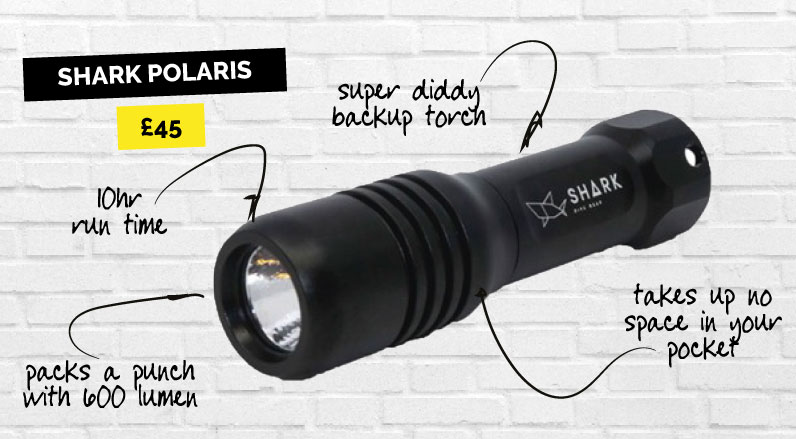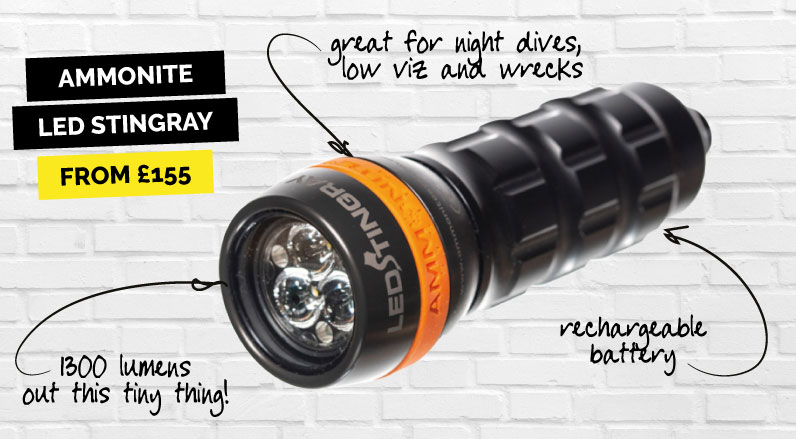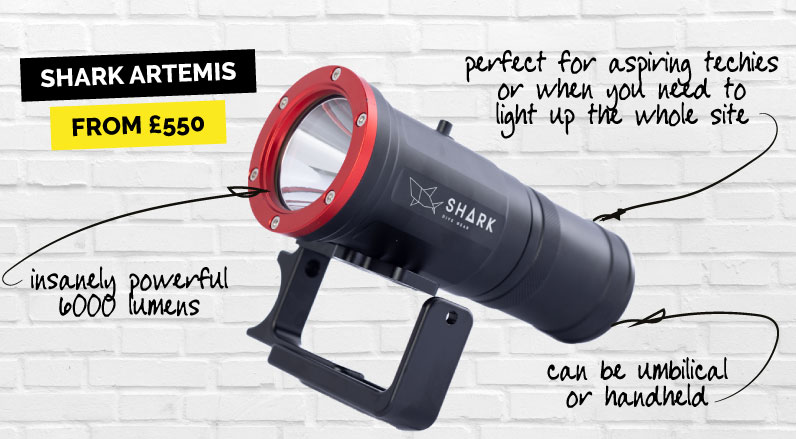If you’re in the market for a new torch, you’re probably reading a load of jargon about “beam angle” and “true lumens”. WTF is a diving torch lumen anyway and how many do I need? Fear not, fellow diver, let me explain and hopefully help find the perfect torch for you!
Diving Torch Lumens… WTF?
First things first: what the fish is a diving torch lumen? In the simplest terms, lumens measure the total amount of visible light emitted by a source – in our case, the LED inside your diving torch. Think of it as the torch’s power output. The problem is, when the people who make the LED measure the lumen rating, then sell it to the scuba manufacturers to put in their torches… the number of lumens changes as soon as it’s installed in the torch housing because of the materials it’s encased in. The reflector and the glass lens affect will reduce the actual power output.
To make matters worse, there’s no standardised way of testing lumens so unfortunately, not all lumens are equal making it var neigh impossible to compare torches on paper.
True Lumens vs. Marketed Lumens
Because there’s a difference between the lumens measured in the LED manufacturer’s lab (let’s call them “marketed lumens”) and the lumens you get once the LED is actually installed in the diving torch, some scuba brands have created something called the “true lumen”. This takes into account factors like the torch’s design, the reflector shape, the glass etc and is a measurement of the actual torch output. But again, there’s no standardisation in these testing procedures between scuba manufacturers, so true lumens still aren’t truly equal.
My best advice is to take the diving torch lumen rating as a general guide. They’re probably not going to be spot on, but you’ll get an idea for the ball park range.
HOW MANY LUMENS DO I NEED?
A lot of divers think, “Great, I’ll just get the diving torch with the highest lumens, and I’m set,” right? Well, not quite as it really depends on the type of diving you’re doing (and your budget – more lumens means more cash!)
I’m like a magpie for torches, I love collecting them. I’ve got everything from tiny little Ammonite Stingrays up to the Shark Artemis which feels like you’re carrying the sun around in a tube.
When I’m diving on wrecks and I want to illuminate as much as I possibly can, the stronger torch is perfect. However, I’ve found that when I take the Artemis on a night dive… it’s just TOO bright. You might as well be doing a day dive! Totally defeats the purpose ?
So, with this in mind here’s a rough guide of lumen ratings based on the typical torches you might use when diving:
BACK UP TORCH – something you shove in your pocket for emergencies – 400 lumen
MAIN TORCH – the one you use on most of your dives (and my preference for night diving too) – 1000 lumen
SPECIALISED TORCHES – for if you’re diving wrecks, cave diving, tec stuff etc – 3000+ lumen
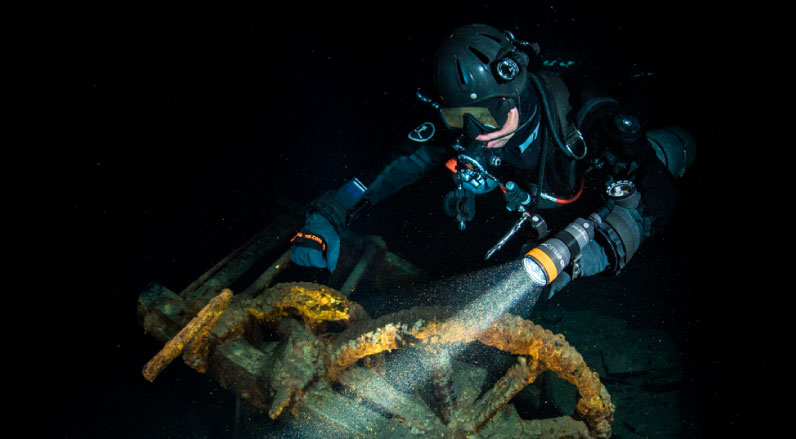
Choosing Your Diving Torch
So, with that in mind, here’s some extra tips and my top recommendations for backups, main torches and specialist gear.
BATTERY LIFE
When we talk about diving torch lumens, it’s easy to get caught up in the brightness and forget about what powers that light – battery life. Just like lumens, batteries aren’t created equal either, and understanding the relationship between lumens and battery life is crucial for choosing the right diving torch.
The type of battery powering your diving torch plays a significant role in both the brightness and the duration of the light output. From rechargeable lithium-ion batteries offering high power and longer life to the convenience of replaceable AA batteries, each has its pros and cons. Advanced torches often feature battery management systems that optimize performance, indicating low battery levels and allowing divers to adjust brightness settings to extend battery life.
For casual reef explorers, a diving torch with a balanced lumen output and battery life that supports 1-2 hours of continuous use might be perfect. For technical divers venturing into the depths of wrecks or caves, a torch with a robust battery life that can last for several hours, or even feature interchangeable batteries, becomes indispensable.
Regardless of the diving torch lumen or battery life, always have a backup. Conditions can change, and so can the performance of your torch. Having a secondary light source, even if it’s a compact torch with lower lumens, ensures you’re never left in a bind.
BEAM ANGLE
While diving torch lumens tell us how bright a torch is, the beam angle shapes the story of what we actually see underwater. It’s like the difference between a spotlight on a stage and the ambient light of a cozy café. Both have their place, but which one is best for you will depend on the type of diving you’re doing.
Diving torches come with a variety of beam angles, each designed for specific underwater activities. A narrow beam angle, often between 7° to 10°, acts like a spotlight. It pierces through the water, allowing divers to focus on distant objects or navigate through murky conditions. It’s the torch you want when you’re exploring the nooks of a wreck or peering into the dark recesses of a cave.
On the flip side, a wide beam angle, typically above 20°, offers a floodlight effect. It illuminates a larger area, making it ideal for general exploration, photography, and video recording. With a wide beam, you get a more natural view of the underwater world, perfect for capturing the vibrant life on a coral reef or ensuring you don’t miss anything in your peripheral vision during a night dive.
It’s important to note that the beam angle can affect the perceived brightness of your torch. A narrow beam concentrates the lumens into a focused area, making it appear brighter at the center. A wide beam spreads the lumens over a larger area, which can make the torch seem less intense but provides a more even light distribution. The choice between a spotlight and a floodlight comes down to what you need most on your dives: detail or breadth.
Some diving torches offer the best of both worlds with adjustable beam angles like the Ammonite LED Nautlius. These versatile torches allow divers to switch between a focused beam for tight spaces and a wide beam for open areas. If you enjoy a variety of diving activities, investing in a torch with an adjustable beam angle could be a game-changer.
COLOUR TEMPERATURE
While diving torch lumens and beam angles are crucial for illuminating the depths, the colour temperature of your torch can dramatically affect how you perceive the underwater world. Colour temperature doesn’t just influence the mood or ambience of your dive; it plays a pivotal role in revealing the vibrant hues and intricate details of marine life that are often lost to the human eye at depth.
Colour temperature is measured in Kelvin (K) and describes the hue emitted by a light source, ranging from warm yellows and reds to cool blues and whites. Underwater, the higher end of this spectrum can help counteract the loss of colours as depth increases, which is why many divers prefer torches with a colour temperature around 5000K to 6500K. These cooler, more natural white lights mimic the sun’s rays penetrating the water, enhancing visibility and making colours pop.
The right colour temperature can make a world of difference in how you experience your dive. For underwater photographers and videographers, a torch with a colour temperature that closely resembles natural sunlight is invaluable. It ensures that photos and videos capture the true colours of coral reefs, fish, and other marine life without the need for excessive post-processing. For recreational divers, a torch with a balanced colour temperature can make every dive more vivid, allowing you to appreciate the full spectrum of colours and details that might otherwise be muted or lost.
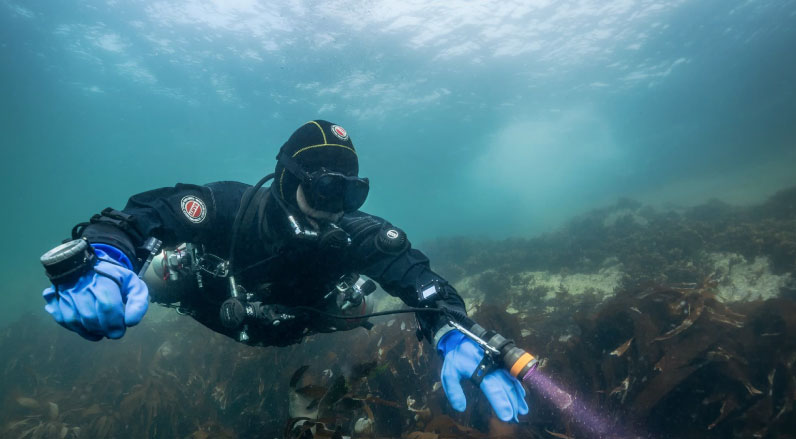
HANDHELD VS UMBILICAL DIVING TORCHES
If you’re on a more extended budget, one of the key decisions you’ll face is choosing between handheld and umbilical (canister) models. This choice isn’t just about comfort or convenience; it’s about matching your light source to your diving style, ensuring that your torch enhances rather than hinders your underwater adventures.
Handheld diving torches are the go-to choice for many divers, They’re simple, easy to use, and very versatile. These torches are designed to be compact and easy to manoeuvre, making them ideal for casual reef dives, night dives, and situations where quick and easy access to light is essential. The primary advantage of handheld torches lies in their portability and the freedom they offer divers to easily switch between lighting angles and positions.
Umbilical torches, on the other hand, consist of a separate light head connected by a cable to a battery canister, which is usually mounted on the diver’s belt or backplate. This design allows for larger batteries, offering significantly longer burn times and often more powerful light output—features that are particularly valuable for technical dives, cave explorations, and extended underwater photography sessions. The separation of the light head and battery canister also reduces the weight in hand, allowing for more precise control and reduced diver fatigue. Plus you look proper cool ?
Some divers choose to carry both types of torches: a powerful umbilical torch for their primary light source and a compact handheld torch as a backup. This approach ensures that you’re prepared for a wide range of diving conditions and scenarios.
MY RECOMMENDATIONS | BACK UP DIVE TORCH : ~400 LUMEN
The Shark Polaris is a great, budget option for a backup diving torch. It’s super small which means it takes up no space at all in your pocket, but it’ll always be there should you need it.
MY RECOMMENDATIONS | MAIN DIVE TORCH : ~1000 LUMEN
I use my Ammonite LED Stingray ALL THE TIME. Believe me when I say that this diving torch has taken a beating! It’s really reliable and durable and the rechargeable battery makes dive prep convenient. To be honest, if you have the budget, one of these makes a great backup too.
MY RECOMMENDATIONS | SPECIALISED DIVE TORCH : ~3000+ LUMEN
If you’re in looking for a more specialist diving torch, the Shark Artemis has blown me away. I took it with me when I was diving in Narvik and it was awesome – it lit up the wrecks beautifully. What’s even cooler with this dive light is that you can choose whether you want it umbilical or handheld, and switch between the setups to best fit the type of diving you’re doing.
In Conclusion: Your Dive, Your Light
Remember, the best diving torch is not the one with the most lumens but the one that suits your diving style and enhances your underwater experience.
If you’re still feeling a bit in the dark about diving torch lumens and which dive torch is the best for you – I’m here to help! Get in touch and together, we’ll find the light that’s right for you.
